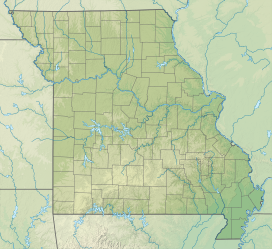| Elephant Rocks State Park | |
|---|---|
 | |
  | |
| Location | Iron County, Missouri, United States |
| Coordinates | 37°39′16″N 90°41′17″W / 37.65444°N 90.68806°W / 37.65444; -90.68806 |
| Area | 133.75 acres (54.13 ha) |
| Elevation | 1,273 ft (388 m) |
| Established | 1967 |
| Administered by | Missouri Department of Natural Resources |
| Visitors | 106,869 (in 2022) |
| Website | Official website |
Elephant Rocks State Park is a geologic reserve and public recreation area encompassing an outcropping of Precambrian granite in the Saint Francois Mountains in the U.S. state of Missouri. The state park is named for a string of large granite boulders which resemble a train of pink circus elephants. The park was created following the donation of the land to the state in 1967 by geologist Dr. John Stafford Brown. The park is used for picnicking, rock climbing, and trail exploration. It is managed by the Missouri Department of Natural Resources.
Geology
The Elephant Rocks, for which Elephant Rocks State Park is named, is a pile of residual boulders of weathered Graniteville Granite. It is a medium- to coarse-grained, muscovite-biotite alkali granite that, on the average, consists of 55 percent alkali feldspar, 40 percent quartz, and less than 5 percent mafic minerals. The Graniteville Granite is a pluton formed 1.4 billion years ago in the Proterozoic by the cooling of magma that intruded into the volcanic strata and country rock associated with a collapsed caldera. Nearly vertical fractures formed in the stone as it cooled, and uplift of the granite enhanced the fracturing. Eventually the overlying strata were removed through erosion, exposing the granite pluton. Before it was exposed, groundwater weathered the granite along fracture joints creating corestones of relatively solid altered granite embedded within friable saprolite. Surface runoff later eroded the saprolite that once surrounded the corestones and left, what are now locally called elephant rocks as boulders perched on the ground surface.
The reddish or pink granite has been quarried in this area since 1869, and two abandoned granite quarries are within the park. These and others nearby have provided red architectural granite for buildings in states from Massachusetts to California, but most particularly in St. Louis, including stone for St. Louis City Hall and the piers of the Eads Bridge. Stones unsuitable for architectural use were made into shoebox-sized paving stones that were used on the streets of St. Louis as well as on its wharf on the Mississippi River. Stone quarried in the area currently is used for mortuary monuments and is known commercially as Missouri Red monument stone.
Activities and amenities
A one-mile (2 km) circular interpretive trail in the Elephant Rocks Natural Area, called the Braille Trail, is the first in Missouri state parks designed specifically for visitors with visual and physical challenges. Spur trails off the main trail include one passing through "Fat Man's Squeeze," a narrow gap between two boulders that leads hikers to an abandoned quarry, and another that goes through "The Maze," a 100-foot (30.48 meter) section of scattered boulders. The park's picnicking area includes ADA-compliant facilities.
References
- "Data Sheet: Elephant Rocks State Park" (PDF). Missouri Department of Natural Resources. November 2017. Retrieved December 28, 2024.
- "State Park Land Acquisition Summary". Missouri State Parks. Retrieved April 25, 2018.
- "Missouri State Park Attendance For January - December, 2022" (PDF). Missouri State Parks. February 3, 2023.
- ^ "Elephant Rocks State Park". Missouri Department of Natural Resources. Retrieved September 29, 2014.
- "Elephant Rocks Natural Area". Missouri Department of Conservation. Retrieved April 25, 2018.
- ^ Kisvarsanyi, E.B. and Hebrank, A.W. 1987. Elephant rocks: a granite tor in Precambrian Graniteville Granite, the St. Francois Mountains, Missouri. In North-central Section of the Geological Society of America, Centennial Field Guide 3, pp. 159-160. doi 10.1130/0-8137-5403-8.159
- Tolman, C.F., and Robertson, F., 1969, Exposed Precambrian rocks in southeast Missouri: Missouri Division of Geological Survey and Water Resources Report of Investigations, 44, 68 p.
- "Elephant Rocks State Park: Cultural History". Missouri Department of Natural Resources. Retrieved April 25, 2018.
- Bullis, Mary Eakins. "Elephant Rocks State Park". River Valley Region Association. Retrieved September 29, 2014.
- "Elephant Rocks State Park: Accessibility Information". Missouri Department of Natural Resources. Retrieved April 25, 2018.
External links
- Elephant Rocks State Park Missouri Department of Natural Resources
- Elephant Rocks State Park Map Missouri Department of Natural Resources